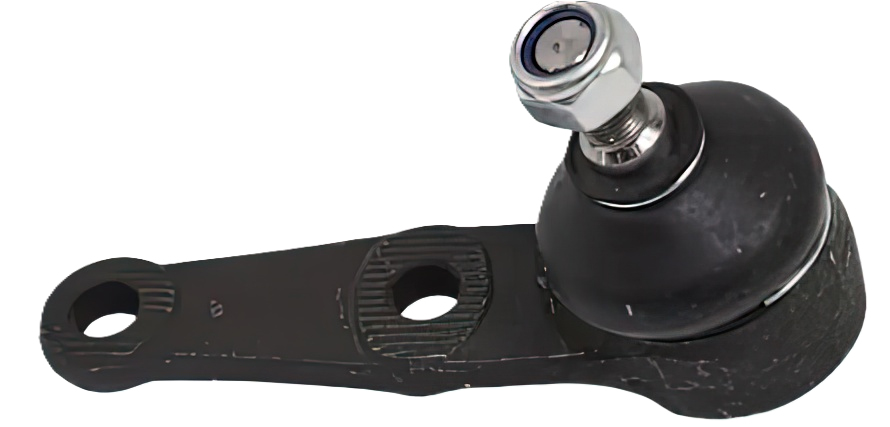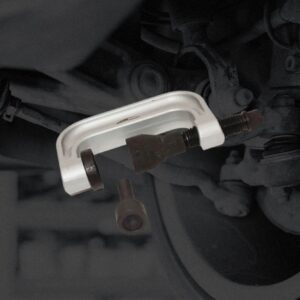Ball joints facilitate movement between your vehicle’s steering knuckles and upper and lower control arms. They’re an integral part of both the front suspension and steering mechanism.
You need to keep them in good shape if you want to pass certain state annual safety inspections and remain safe while on the road. But how much is a ball joint replacement, and what are the signs your vehicle needs one?

How Much Does a Ball Joint Replacement Cost?
Ball joints replacement can cost approximately $250 to $500 per ball joint for most vehicles. But on vehicles with bolt-on rather than press-in ball joints the cost will be a lot less.

The price can also go up for more exotic European vehicles and sports cars. Non-greasable ball joints will cost about $100 to $200 per ball joint, but they have shorter lifespans. Usually if the boot remains intact so that the grease is retained, the ball joint will last the life of the vehicle.
If you’re also going to request an alignment, it’ll cost an additional $100 depending on the prices shops charge in your area. The mechanic replacing your vehicle’s ball joints will likely need to perform an alignment anyway just to make sure that the suspension is in order.
How Long Does a Ball Joint Replacement Take?
Ball joint replacement can take anywhere from one to three hours. If you can get a packaged deal for multiple ball joint replacements from one shop, it might save you some labor costs.
What Are Car Ball Joints?
A car ball joint consists of two main parts. First is a stud, which rotates inside a metal housing. The second is a socket that sits inside a lubricated casing. Together, these parts create the ball joint, which absorbs some of the shock that goes through the vehicle’s front suspension system. While the vehicle is moving, the ball stud moves, making the vehicle easier to steer and support. Ball joints also connect the vehicle’s wheels to the steering and control systems. Upper ball joints are non-load-bearing, and lower ball joints are load-bearing.
Without these ball joints, vehicle tires wouldn’t run or turn as smoothly as they usually do. They connect the steering knuckles and control arms, ensuring the knuckles stay attached while also giving those knuckles the freedom to turn in various directions. They also facilitate tire movement, allowing the wheels to move up and down or side to side for a smoother drive.
When To Replace Car Ball Joints
Ball joints will ideally last between 70,000 and 150,000 miles before showing signs of failure. A ball joint’s lifespan might vary depending on your driving habits, road conditions, and its manufacturer.
Signs of an Inoperative Car Ball Joint

Always replace a car ball joint when it starts to show failure signs. Some symptoms of an inoperative or failing ball joint include the following items:
- Loud popping or squeaking noises from the corner of your vehicle while driving over uneven road surfaces
- Noticeable steering wheel vibrations
- Steering issues
- Uneven tire wear
- Misaligned or damaged suspension or wheel components
Should You Replace Car Ball Joints at Home?
Replacing ball joints isn’t easy on most vehicles, and if you’re not familiar with automotive suspension system work, you probably shouldn’t attempt it. More experienced DIYers who are familiar with changing suspension and brake components might be able to handle the project, but it’s a messy job. If you aren’t confident in your DIY abilities, it’s best to bring your vehicle to an auto repair shop for car ball joint replacement. They’ll have the know-how and the tools available to replace the ball joints easily. Typically, their process will include these steps:
- Removing the wheels
- Moving the brake calipers and rotor, along with the sway bar links on specific vehicles
- Separating the lower control arm from the steering knuckle in front-wheel-drive cars
- Separating the steering knuckle from the ball joints using a large hammer in tucks and some cars
- Inspecting and removing the snap rings that hold the ball joint in place
- Pressing the old joint out of the control arm using a ball joint press
- Pressing a new joint into the control arm using the same ball joint press.
Your vehicle’s repair manual might also contain detailed repair instructions. You can also check online for this info.
Driving With an Inoperative Ball Joint
Driving with damaged ball joints is a bad idea as your car can sustain more damage.
Ball joints are a vital part of your vehicle’s suspension system. Now that you know more about how much ball joint repairs cost and how long they’ll take, you know what to do in case this part wears out.
Taking Care of Your Vehicle’s Ball Joints
Regularly inspecting the ball joints, greasing them, avoiding rough roads, traveling light, and making sure the wheels are properly aligned can help keep your suspension system in tip-top shape.
Regular Inspection
It’s always a good practice to have your vehicle inspected for signs of wear and tear. By doing this, you can improve the lifespan of your ball joints as well as any other component that wears over time. It’s strongly recommended to have your car serviced by a professional at least twice a year.
Grease the Joints
Another effective way to take care of your vehicle’s ball joints is to grease them from time to time.
Travel Light
Driving with a heavy load puts a lot of strain on your vehicle’s suspension system. This includes the ball joints. If you want to take good care of your vehicle, travel light as often as possible and drive with heavy loads only when necessary.
Avoid Rough Terrain
Avoid rough and rocky roads if you want to take good care of your vehicle’s ball joints. Rocks and unpaved roads cause vehicles to jitter and jerk as you drive, vibrating and putting more strain on various components – ball joints included.
Wheel Alignment
Ensuring your vehicle’s wheels are aligned is a good way to reduce the stress placed on the ball joints when you drive. Proper wheel alignment also ensures your vehicle handles properly, improving your control over your car as you drive.
Any information provided on this Website is for informational purposes only and is not intended to replace consultation with a professional mechanic. The accuracy and timeliness of the information may change from the time of publication.

































